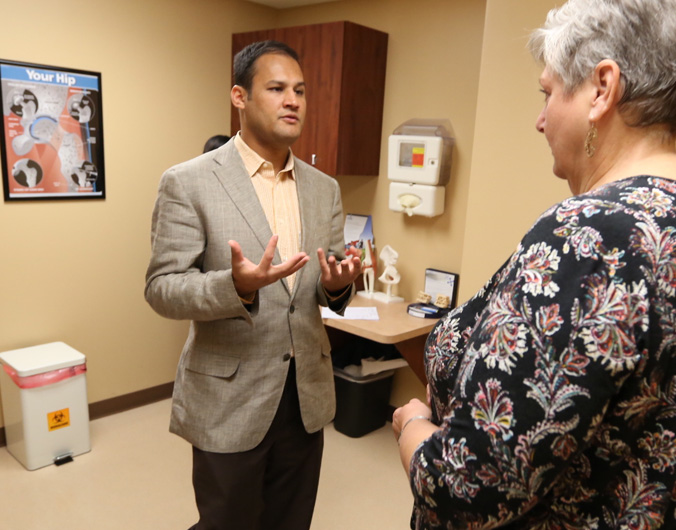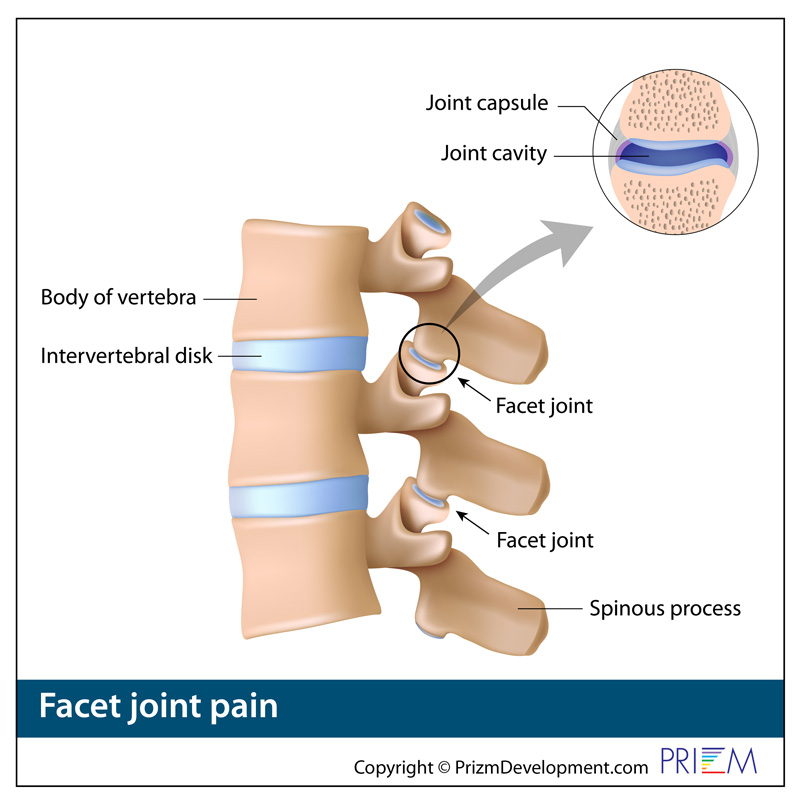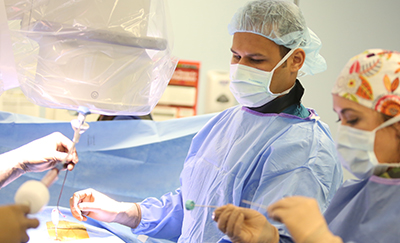Facet Joint Problems
The facet joint is on the back of the spinal vertebrae, and acts like a hinge between vertebral segments. Facet joints are located between each vertebra and provide flexibility to the spine that allows you to bend and twist your back.
Each vertebra has two sets of facet joints, one facing upward (superior articular facet) and one downward (inferior articular facet) on each side (right and left). These joints act like hinges linking the vertebra together to form your spine. In order for the facets to be an effective hinge, each cartilage-coated joint is surrounded by a capsule of connective tissue and fluid that lubricates the joint allowing them to smoothly glide against each other. The nerve supplying the joint is called a medial branch.
Sometimes, facet joint problems can develop from arthritis or injury.
Facet joint and medial branch blocks are used for patients with pain stemming from inflammation or irritation of the facet joints. These patients normally do not respond to other conservative means, such as oral anti-inflammatory medication, rest, or physical therapy.
These procedures usually are performed for management of severe acute or chronic pain affecting the back or neck. They may also be performed for testing purposes by providing valuable diagnostic information about your condition. For example if your back pain or neck pain responds to a therapeutic injection, that can provide valuable information to the surgeon that a specific facet joint level is actually the pain generator.
A facet block is an injection of local anesthetic and steroid into the facet joint in the spine. A medial branch block is similar but the medication is placed outside of the joint near the nerves that supply the joint called the medial branch.
Based upon your symptoms or diagnostic tests that show an internal image of your spine, the injection can be directed into the facet joint or can target the nerves close to the joint, thus, a facet joint block or facet joint nerve block, called a medial branch block.
During the injection procedure, the patient lies face down. Using a C-arm for X-ray guidance, the spinal injectionist identifies the specific level of the spine that will receive the injection. After cleaning the skin and placing sterile drapes, the physician numbs a small area of skin. Most patients will note that the initial sensation of the numbing medicine is perhaps the only discomfort felt from the injection procedure.
 Using X-ray guidance of the C-arm, the physician then guides a small needle to either the facet joint or the medial branch. In confirming the correct needle placement, the injection may initially create a response, which could be identical to the pain under investigation, similar but not identical, or a different or new sensation. The medication is then injected around the facet joint or near the nerves supplying the joint.
Using X-ray guidance of the C-arm, the physician then guides a small needle to either the facet joint or the medial branch. In confirming the correct needle placement, the injection may initially create a response, which could be identical to the pain under investigation, similar but not identical, or a different or new sensation. The medication is then injected around the facet joint or near the nerves supplying the joint.
There will be a short recovery time in a nearby room where you may sit in a recliner and your blood pressure will be checked and you will be monitored for any complications or side effects. Typically, you will be allowed be be driven home within an hour.
Facet joint blocks or medial branch blocks can provide pain relief that lasts from days to years. If you get good, lasting benefit from the injections, the procedure may be repeated. If you get good, short-term benefit, you could be considered for another procedure called facet rhizotomy (radiofrequency ablation), which may provide longer-term relief of months to years. If you do not get any benefit from the procedure, the block still has diagnostic value in that it means that the pain is likely not coming from the targeted facet joints.
Maahir Haque, MD is recognized as a leader in the field of minimally invasive spine surgery. At Spine Group Orlando, Dr. Maahir Haque also provides second opinions for spine surgery and MRI reviews for those with back pain and neck pain. Dr. Haque emphasizes non-surgical options for back pain and neck pain where possible. This can include accessing a back pain specialist with expertise in pain-relieving spinal injections and spine therapists. Spine therapy can include back stretches that can be a future home remedy for back pain or neck pain. If spine surgery is necessary because of a herniated disc, spinal fracture, or spinal stenosis, Dr. Maahir Haque operates through tubular retractors that reduce the size of the incision, lessen blood loss, reduce time in the hospital, speed return to activity with a less painful recovery. This spine surgery expertise enables many patients to have outpatient spine surgery and be home the same day. Spine Group Orlando and Dr. Maahir Haque provides artificial disc replacement in the neck using the Mobi-C disc implant, the first FDA-approved disc for multiple levels in the neck. Prodisc-C is also used for artificial disc replacement in the cervical spine. Dr. Haque is also one of the few spine surgeons in Orlando, Florida to provide lumbar artificial disc replacement using the Prodisc-L artificial disc. Dr. Haque is also referred patients from across Orlando and north central Florida for artificial disc replacement surgery as an alternative to spinal fusion. Accordingly, Dr. Haque's patients travel from across north central Florida, including: Orlando; Jacksonville; Tallahassee; Lakeland; Gainesville; Tampa; Daytona Beach; and Cocoa Beach. The spine center, as a destination for medical tourism for some international patients from Mexico and the Caribbean, can provide recommendations to out-of-town patients on nearby hotels and tourist attractions. Dr. Haque is featured on the national site CentersforArtificialDisc.com as an author on the subject of artificial disc replacement for herniated discs in the neck. The Centers for Artificial Disc web site has content specific to disc replacement options and alternatives to spinal fusion. Click here to visit the Centers for Artificial Disc.








